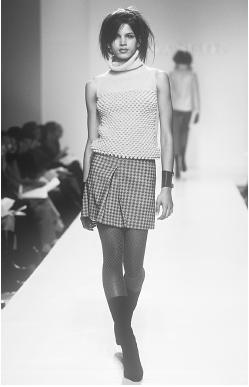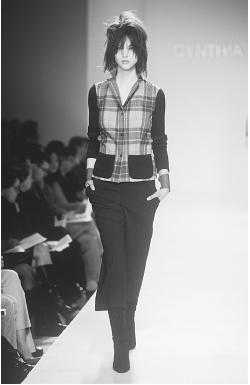Cynthia Steffe - Fashion Designer Encyclopedia
American fashion designer
Born: Sioux City, Iowa, 30 June 1957. Education: Parsons School of Design, 1978-81. Family: Married Richard W. "Rick" Roberts, 1984. Career: Designer for Donna Karan and Louis Dell'Olio at Anne Klein & Company, 1981; designed women's tailored separates for Spitalnick & Company, 1983-88; consultant for Crystal Brands, 1988-89; chaired Cynthia Steffe Inc., 1989-2000; joint designing of

Publications
On STEFFE:
Books
Hodgman, Ann, A Day in the Life of a Fashion Designer, Mahwah, New Jersey, 1988.
Stegemeyer, Anne, Who's Who in Fashion, Third Edition, New York, 1996.
The Complete Marquis Who's Who, 2001.
Articles
"Steffe Leaves Spitalnick," in WWD, 18 January 1988.
"Steffe Joins Crystal Brands," in WWD, 16 March 1988.
Rosenblum, Anne, "Steffe Line Poised for Fall Debut," in WWD, 10 November 1988.
——, "Cynthia Steffe: A Class Act," in WWD, 1 February 1989.
"Cynthia Steffe Premieres," in WWD, 29 March 1989.
Schiro, Anne-Marie, "Cynthia Steffe," in the New York Times, 28
August 1989.
Delaney, Joan, "Designing Woman," in Executive Female, September-October 1990.
"The 50 Most Beautiful People in the World," in People, July 1991.
Friedman, Arthur, "Tepper Gets Coat License for Steffe," in WWD, 11 April 1995.
"Steffe Makes Up," in WWD, 25 October 1995.
White, Constance C.R., "Sleek Powerbroker Suits and Cool Characters," in the New York Times, 1 November 1995.
Ozzard, Janet, "Cynthia's Steady Course," in WWD, 20 December 1995.
"Savvy Take on Rocky Retail Era…" in Crain's New York Business, 4 March 1996.
Ozzard, Janet, "Cynthia Steffe Stretches Out," in WWD, 12 February 1997.
Bounds, Wendy, "Behind the Scenes at a Designer's First Show," in the Wall Street Journal, 25 April 1997.
Avery, Nicole Volta, "Cynthia Steffe Showcases Spirited Designs for Hudsons," in the Detroit News, 23 March 1998.
"Leslie Fay to Buy Cynthia Steffe Inc.," in WWD, 20 April 2000.
Homan, Becky, "Snake Charmers," in the St. Louis Post-Dispatch, 20 May 2000.
Mayer, Robin Long, "Tradition Honored," in Country Living, May 2001.
"In Cynthia's Closet," in Ladies Home Journal, August 2001.
"Cynthia Steffe," available online at Fashion Dex, www.fashiondex.com , 2001.
Davis, Boyd, "New Generation: Cynthia Steffe," online at Fashion Windows, www.fashionwindows.com , 10 November 2001.
Davis, Mari, "Cynthia Steffe: A View from Backstage," online at Fashion Windows, www.fashionwindows.com , 10 November 2001.
***
Cynthia Steffe, developer of Cynthia Steffe Collection, Cynthia's Closet, and Francess & Rita, used market savvy to ease her way into a highly competitive field. Born in Sioux City, Iowa, in 1958, she grew up in Boyden. In her teens, she emulated her mother's flair for clothes by sketching and sewing her own outfits. After Steffe chose fashion for her career, she entered New York City's Parsons School of Design at age 19. Before graduating in 1981, she snagged both the Student Designer of the Year and the Donna Karan Gold Thimble awards.
Immediately signed with Donna Karan, Steffe worked for Karan and Louis Dell'Olio at Anne Klein & Company. She began designing women's tailored separates for Spitalnick & Company in 1983 and left in 1988 to consult for Crystal Brands, maker of clothing for women, men, and youth under the Izod, Lacoste, and Ship 'n' Shore labels and Monet costume jewelry. A gift for design earned her a place among People Weekly 's "50 Most Beautiful People in the World." Women's Wear Daily classed her as one of the "New Majors," a slate of tyros including Jennifer George, Rebecca Moses, Charlotte Neuville, and Carmelo Pomodoro, the five new names fashion pundits predicted would take the place of older, fading fashion houses.

Steffe realized the only way to impact the market with original, unedited designs was to market them herself. In partnership with Ira J. Hechler & Associates, in March 1989 she launched Cynthia Steffe Inc., a 2,500-square-foot showroom at 575 Seventh Avenue to wholesale her creations in the $100 to $400 range. She involved herself at all levels, from design and administration to production and sales. Assisting her was company president Richard W. "Rick" Roberts, formerly president of Alexander Julian Womenswear for two years and director of the Calvin Klein Studio Division for two years. She had met Roberts in her sophomore year at Parsons and married him in 1984.
Chairing her own company, Steffe aimed for the best in fabric, detail, and construction to give buyers more value for their fashion investment. In anticipation of demand for luxury items and novelty fur pieces, she showed a first 50-item collection featuring blanket coats, tunics, kimono jackets, cigarette pants, bolero jackets, and faux furs in fundamental gray, navy, and black. To punch up her line, she stressed interesting buttons, trims, and shawls. Anne Rosenblum of Women's Wear Daily quoted Steffe's aim: "I am designing for a woman with a high taste level, who wants quality at a price she can afford."
Steffe's interest in a less monied class of shopper caught the fashion world's attention. Joan Delaney, writing for Executive Female, summarized Steffe's appeal: "By skirting fashion shows, this material girl delivers designer duds for fewer dollars." Steffe pushed herself to top previous years' successes with something wearable and eye-catching, including affordable crêpes, mohair boucles, wool jacquards, and suedes. Her niche was the bridge between the mass merchandising of Evan Picone and Jones of New York and exclusive originals by Calvin Klein. In 1990 Spiegel featured her contemporary designs in its 125th anniversary catalogue.
A year later, when Steffe was named one of the world's most attractive people, she told People, "I want a youthful personality to my clothes." CBS fashion analyst Pat George confirmed Steffe's choice of direction and ventured a prediction: "Her clothes are right on and her colors are original. She will be another Liz Claiborne or Adrienne Vittadini." In 1995 Steffe began cautiously branching out in a joint effort with Prescriptives on the introduction of Understatements '96, a cosmetics line, and made her first venture into licensing with Jeff Tepper's collection, for which she produced luxury coats in fur-trimmed alpaca velvet, angora flannel, shearling, leather, and shimmer sateen for sale at Saks Fifth Avenue and Neiman Marcus. Accounting for around two-thirds of her wholesale business in 1995 was the office-minded Francess & Rita line. Steffe told Women's Wear Daily, "We went after the market of women who wanted something to wear to work but wanted a little more style."
At her headquarters, Steffe acknowledged the uphill struggle in a cooling department store market that saw the demise of Ames, B. Altman, and Bloomingdale's and the sale of Saks. Fewer department stores meant stiffer competition for those that survived the shakeout; in retrospect, she commented that the 1980s offered a more forgiving fiscal climate: "Today, you can't afford to make a mistake. You really have to know your customer."As company pilot in chancy waters, she hired Susan Portnoy from Nicole Miller as public relations manager and initiated an aggressive advertising and promotion campaign.
After steadily advancing in sales to about $22 million in wholesale goods annually, in 1997 Steffe's company added a secondary line with the security of the Frances & Rita line, the office-friendly sportswear label, anchoring the firm. To Janet Ozzard of Women's Wear Daily, president Rick Roberts exulted, "The company is seven-and-a-half years old, and it's been consistently profitable for the last five."
Boldly thrusting into new territory, Steffe's designs reached out to women who buy individual wardrobe items rather than whole costumes. She offered narrow coats, slim shirtdresses and skirts, boot-leg pants, and double-breasted jackets over man-tailored trousers. To put more texture into the line, she featured fake fur, leather, stretch cotton and napa satin, wool pinstripe, burnout velvet, Lycra spandex twill, wool pebble crêpe, Lurex, and rayon or chenille yarns. She held down prices by buying from the second tier of expensive mill collections. In late April 2000, Steffe sold her firm to Leslie Fay Company, Inc.
At the beginning of a new millennium, Steffe was still pursuing texture by adding reptile prints and mottled touches to her designs as well as softly draped materials to her home. Targeting twentysomethings, she captured the Jackie look of the 1960s with matching rainwear as well as retro riding gear, asymmetrical hem-lines, belts, leggings, and the indispensible purse to hold makeup and cell phone. In May 2001 Country Living featured the mountain getaway of Steffe and her husband. Departing their New York City apartment, they retreated to Calicoon, New York, in the Catskill Mountains, where she coated walls and ceiling in creamy and ivory fabric lengths to reflect natural light.
In August 2001 Ladies Home Journal summarized the designer's unique sense of workable style. The choice of a monochromatic base enabled her to simplify shopping, accessorizing, and moving from 14-hour days to evening. Steffe confided, "Open my closet and it's a sea of black. I work with color all the time, so I wear black because it's the perfect backdrop to drape my fabrics against when I'm designing."
—Mary Ellen Snodgrass
Comment about this article, ask questions, or add new information about this topic: